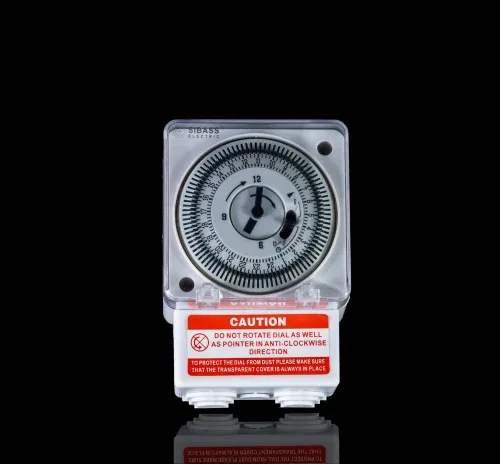
An analog timer is a type of timer that uses mechanical components and an analog dial to measure and control time. Unlike digital timers, which use electronic circuits and displays to show time, analog timers typically feature a rotating dial with a clock face and a pointer set to the current time.
Here’s a breakdown of how an analog timer works and its key features:
Key Features :
- Dial or Rotating Knob: Analog timers usually have a circular dial or a rotating knob that is used to set the current time.
- Clock Mechanism: These timers are often driven by a clock mechanism, similar to how a traditional clock works. They may use gears and springs to control the passage of time.
- Pointer/Hand: As time passes, a pointer or hand moves around the dial, showing the current time and the time remaining to the pre set time.
- Adjustable Time Settings: You can set the timer by moving the tiny switches up. Each switch indicates a period of 15 minutes.
- Audible Alarm: Many analog timers include a bell or a mechanical alarm that sounds when the time is up.
- Manual Control: Analog timers typically require manual setting and resetting for each use.
Uses of Analog Timers :
- Industrial/Household Appliances: Can be used for controlling the operation of appliances (irrigation systems).
- Time Management: For tracking time for activities like work sessions, study periods, or exercise routines.
- Streetlight control: Can be used for auto ON and OFF of streetlights.
Types of Analog Timers :
- Mechanical Timer: The most common type, using gears and springs to keep time.
- Spring-Wound Timer: Uses a spring that is wound manually to store energy for the timing function.
- Countdown Timer: Often used in situations like cooking or in experiments, where time counts down from a set duration.
What are the four types of timer switches?
4 Types of Electric Timers. …
- Mechanical Timers (Analog/Manual) …
- Digital Timers (Programmable and Smart) …
- Astronomic Timers. …
- Photocell.
What is the principle of timer switch?
With timer operation, the Time Switch controls the output according to the set ON and OFF times. With pulse-output operation, the Time Switch outputs a pulse of a specified time width at the set ON time. Power turned ON by a Time Switch. warmed up before the employees come to work so that work can begin immediately.
What is the difference between analog and digital timers?
As mentioned above, analog timers use a dial to set time, while digital timer uses a soft button to do so and features a clear LCD or LED display, so analog timers operational flexibility is not as good as the digital one.

